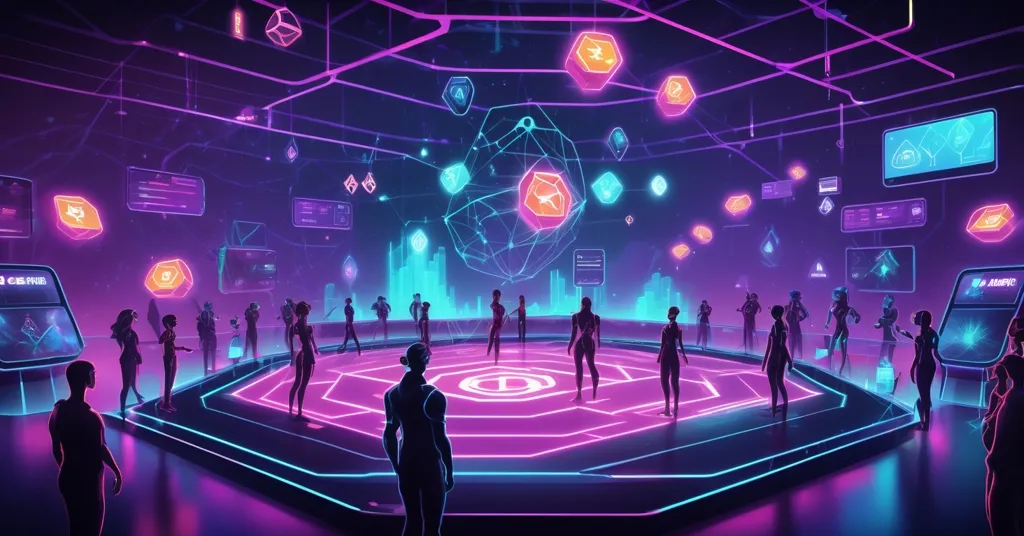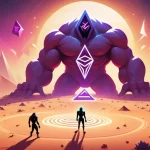BORA Price Prediction 2025: Can This GameFi Crypto Double to $0.26?

BORA Price Prediction 2025: Can This GameFi Crypto Double in Value?
Bora (BORA), a lesser-known altcoin with a sharp focus on gaming and entertainment, is stirring curiosity among crypto enthusiasts. Positioned in the burgeoning GameFi sector, where blockchain meets play-to-earn economics, BORA promises a unique niche—but are the whispers of a price doubling by 2025 grounded in reality, or just another speculative fever dream?
- Price Speculation: Forecasts for BORA range from a hopeful high of $0.26 in 2025 to a staggering $0.85 by 2030, with lows of $0.10 if markets collapse.
- Growth Catalysts: Partnerships like LINE NEXT and Web3 gaming upgrades could propel BORA, but volatility and competition loom large.
- No Hype Zone: We’re cutting through bullish noise to weigh real potential against glaring risks in this GameFi contender.
What Is BORA? Unpacking the GameFi Token
BORA is a cryptocurrency tied to a decentralized platform tailored for gaming and entertainment, aiming to be a powerhouse in the GameFi niche—a fusion of gaming and decentralized finance (DeFi). GameFi lets players earn crypto through play-to-earn models or trade in-game assets as NFTs (non-fungible tokens), creating mini-economies within virtual worlds. Unlike many tokens that rely on costly networks like Ethereum, BORA operates as a sidechain to Kaia (formerly Klaytn), a blockchain focused on metaverse and gaming apps. A sidechain is essentially a secondary blockchain linked to a primary one, designed to handle specific tasks like gaming transactions faster and cheaper. At its core, BORA acts as a bridge between gamers and developers, enabling low-cost transactions, staking, and NFT integrations without the wallet-draining gas fees that plague other platforms. For a deeper dive into its ecosystem, check out this BORA GameFi overview.
As of now, one BORA token trades at around $0.10, with a market cap of roughly $119 million. With a circulating supply of about 1.1 billion out of a maximum of 1.205 billion, it’s a small fry in the crypto ocean, but its specialized focus makes it a dark horse worth watching. BORA’s ecosystem already supports titles like ArcheWorld, a blockchain MMORPG, and Birdie Shot, a casual golf game. Yet, without hard data on player counts or revenue, it’s tough to tell if these are breakout hits or just proof-of-concept experiments.
BORA Price Forecast: Hype vs. Reality
Let’s get to the meat of the matter—those shiny price predictions for BORA. Some bullish forecasts suggest the token could hit a high of $0.26 by 2025, averaging $0.18, though a market downturn might drag it down to $0.10. Looking further, optimists see it crossing $0.50 by 2028 and soaring to $0.85 by 2030. Before you start pricing out yachts on CoinMarketCap, let’s inject a dose of reality. More conservative outlooks peg BORA at a modest high of $0.13 for 2025 and $0.24 for 2030. The massive gap between these estimates screams uncertainty—crypto predictions are often just darts thrown at a board, and BORA’s trajectory is no exception. For a detailed breakdown of these forecasts, take a look at this BORA price analysis for 2025 and beyond.
Why the optimism for BORA crypto in 2025? A key driver is its strategic partnership with LINE NEXT, a move to distribute Web3 mini DApp games through a dedicated portal, tapping into Asia’s mobile gaming obsession. Then there’s the BORA 3.0 roadmap, packed with upgrades like deeper Web3 gaming integration, enhanced liquidity pools for DeFi (think shared pots of crypto for seamless trading or lending), gas abstraction (hiding transaction fees from users for a smoother experience), and a new tokenomics model with dynamic token burning. Burning means destroying tokens to reduce supply over time, which could nudge prices up if demand holds. But let’s be real—these are plans, not guarantees. Execution is everything, and crypto history is littered with roadmaps that led nowhere. Curious about community takes on these predictions? Check out this Reddit-driven BORA forecast for 2025.
GameFi Market Boom: Can BORA Ride the Wave?
The broader GameFi sector adds some wind to BORA’s sails. Analysts project this market could explode to over $200 billion by 2034, growing at a scorching 27-28% annually. If BORA snags even a tiny slice of that pie, especially with Kaia’s ambition to be Asia’s Ethereum rival through messaging app integrations and Ethereum Virtual Machine (EVM) compatibility, the upside could be serious. Community buzz on platforms like X also plays a role—during “altcoin seasons,” when Bitcoin dominance dips and speculative cash floods into riskier tokens, projects like BORA often see price spikes fueled by pure sentiment. To understand its competitive landscape, explore these Web3 gaming industry trends.
But don’t pop the champagne yet. Sure, GameFi sounds like the future, but what if players grow bored of grind-to-earn mechanics? What if major game studios balk at blockchain’s complexity or cost? BORA’s niche could be its Achilles’ heel if the hype doesn’t translate to sustained adoption. And while Kaia’s governance model promises growth, any stumbles could ripple straight to BORA, tanking its prospects faster than a bad NFT drop. For more on its blockchain foundation, see this analysis of Kaia and BORA’s integration.
BORA vs. GameFi Giants: Enjin and Gala in the Ring
BORA isn’t playing solo in the GameFi arena—it’s up against heavyweights like Enjin Coin (ENJ) and Gala (GALA). Enjin has a well-established NFT ecosystem, powering in-game assets across countless titles with a developer-friendly toolkit. Gala, meanwhile, spans gaming and music, boasting a broader entertainment appeal with high-profile partnerships. BORA’s edge? Lower transaction costs thanks to its Kaia sidechain setup, which could lure budget-conscious devs and players. But without Enjin’s reach or Gala’s star power, BORA must hustle to differentiate itself. If it can’t onboard more hit games or prove user traction, it risks being sidelined as just another altcoin wannabe.
Risks and Roadblocks: Why BORA Might Stumble
Now, let’s talk about the ugly side—crypto is a brutal space, and BORA isn’t immune to its punches. Market volatility is a given; a global financial meltdown or broader crypto crash could easily shove BORA down to that $0.10 low—or lower. Regulatory risks are another beast, especially in GameFi. Play-to-earn models and NFT integrations have caught the eye of lawmakers worldwide, with South Korea (a gaming hub) flip-flopping on crypto policies and the EU and US sniffing around for gambling-like mechanics or tax loopholes. If jurisdictions crack down on in-game earnings, BORA’s core use case could crumble overnight. For a community perspective on its potential, see this Quora discussion on BORA’s role in Web3 gaming.
Then there’s the staking mess. BORA tokens are used for transactions, staking, and issuing service tokens within its ecosystem, but there’s murkiness on whether direct staking is widely supported on major platforms. Some say rewards come from platform use or token locking, others claim it’s not straightforward. For yield-chasing investors, this ambiguity is a glaring red flag. Add to that BORA’s tethering to Kaia—if Kaia fumbles its governance or fails to attract devs, BORA feels the pain. Short-term sentiment isn’t exactly roaring either; recent analyses label BORA’s outlook as “Neutral” with a Fear & Greed Index of 64 (leaning “Greed”), while some near-term forecasts hint at bearish pressure. For more on these dynamics, review this BORA and LINE NEXT partnership analysis.
Where to Trade BORA: Accessibility vs. Stability
For those still itching to jump in, BORA is available on exchanges like Indodax, Bithumb, Coinbetter, and Coinone, offering decent access for retail investors. But accessibility doesn’t mean safety. BORA’s history—from a private Ethereum Layer 2 in its BORA 1.0 era to a Klaytn-based pivot in BORA 2.0—shows a team willing to adapt for scalability. Its Practical Byzantine Fault Tolerance consensus (via Kaia) skips traditional mining for efficiency, which is smart but might not vibe with Bitcoin purists who live for proof-of-work’s raw decentralization. Altcoins with hyper-focused niches like BORA can fade fast if they don’t nail user adoption, and no exchange listing guarantees staying power. For the latest updates on its tech upgrades, browse these Reddit discussions on BORA Chain and DeFi features.
BORA’s Place in the Crypto Revolution
As someone who’d bet on Bitcoin over any altcoin nine times out of ten, I’ll grudgingly admit BORA’s niche play in gaming is a compelling detour—provided it doesn’t crash and burn like countless specialized tokens before it. Bitcoin remains the gold standard for sound money and decentralization, but altcoins like BORA test blockchain’s boundaries in everyday life. GameFi isn’t just a gimmick; it’s a potential gateway for millions to touch crypto without even realizing it. Yet, for every success in this space, there are a dozen rug pulls or forgotten projects. BORA embodies the wild, experimental spirit we champion in effective accelerationism—pushing disruption while staying ruthlessly critical.
A word of caution: beware of X shills or YouTube hacks swearing BORA will “10x overnight.” Crypto isn’t a lottery ticket, and blind hype is often the first sign of a scam. We’re here to drive adoption, not delusion. The potential for BORA to double to $0.26 by 2025 isn’t pure fantasy if partnerships and upgrades click, but it’s a long shot without concrete user numbers. Those $0.85 dreams for 2030? Borderline fan fiction until adoption proves otherwise. If you’re diving in, do it with eyes wide open, not stars in them. For a fact-checked take on some of these claims, see this critical review of BORA price prediction accuracy.
Key Takeaways and Questions on BORA’s Future in GameFi
- What is Bora (BORA) and why does it stand out in GameFi?
BORA is a cryptocurrency and platform targeting the GameFi sector, merging gaming with decentralized finance. As a sidechain on Kaia, it offers low-cost blockchain solutions for gamers and developers to trade NFTs or earn tokens via play-to-earn setups. - Can BORA double to $0.26 by 2025 based on price predictions?
Some BORA price predictions for 2025 hit a high of $0.26, driven by Web3 gaming upgrades and partnerships like LINE NEXT. However, cautious estimates cap it at $0.13, and market crashes could drop it to $0.10, showing the speculative gamble. - What fuels BORA’s potential in the Web3 gaming market?
Collaborations like LINE NEXT, BORA 3.0 innovations, and a GameFi sector projected to reach $200 billion by 2034 spark optimism. Token burning to shrink supply could also lift value if demand surges. - What are the biggest risks to BORA crypto’s growth?
Volatility, regulatory crackdowns on play-to-earn models, competition from Enjin Coin and Gala, and reliance on Kaia’s success threaten BORA. Staking ambiguity further clouds investor appeal. - How does BORA contribute to the broader blockchain revolution?
While Bitcoin rules as decentralized money, BORA shows altcoins can carve niche roles. Its gaming focus could onboard everyday users to crypto, aligning with our push for disruption—if it survives the hype cycle.
BORA represents the kind of bold experiment that keeps crypto exciting, and frustrating. It’s a wager on a future where gaming and blockchain fuse into something transformative. Supporting such innovation is how we accelerate a decentralized world, but only if we keep the conversation rooted in facts over fantasy. Let’s cheer on projects like BORA to shake up the status quo, while holding them to the fire of real-world results.



